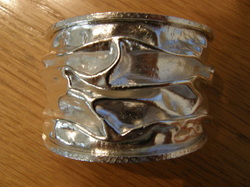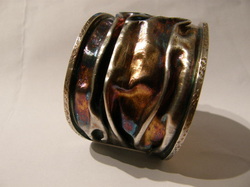Using fine silver allow the folds to happen without the work hardening and potential cracking to occur. The sterling silver frame adds some rigidity - you could use fine silver too but to prevent the cuff from bending out of shape too easily, so using sterling and its work hardening propensity, keeps the cuff in shape.
I was going to allow the white tarnish from heating and pickling to stay in the folds to give these deeper spots a matt look; and then using a buffing cloth, I was going to polish the frame and hight spots on the fold.
Part of the reason behind this matt/shiny look was that I don't like the 'normal' gray patina look which you get with LOS on silver. Having used LOS on copper, I love the various colors that can be obtained yet on silver you only see gray to black tones.
There has to be something else that can be done!
Doing some reading from my patina book; I came across a recipe that indicated that you can get golds, pink/purples, and blues on silver just like i do on copper. Coooool but how hard was it going to be?
To get this effect, the first thing I had to do was scrub the cuff and remove all the oxides and finger oils. Then set up the LOS bath with the dipping station, running water, steel wool, gloves and safety glasses. I also turned on all the lights so I could see the patina develop.
I went at it very slowly and wow, what amazing results. My view of LOS on silver has just changed. After using the LOS, I went back with my steel wool and rubbed the patina off the frame and the high spots on the folds since wearing the bracelet over the time would wear away the patina on these spots. Secondly doing this allows the white of the silver to shine through and add a great contrast to the colors from the patina
The first picture below is before LOS and the second is after the patina process is over.
And I love my bracelet, it is really, really, really amazing. I have to finish up one more as I promised it to Elisa of Scotland.




 RSS Feed
RSS Feed
